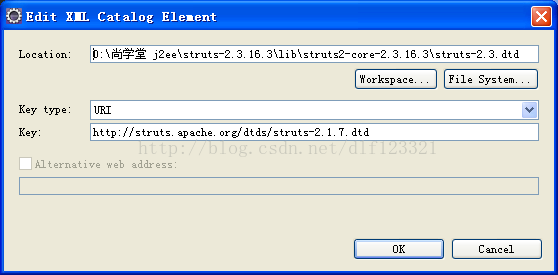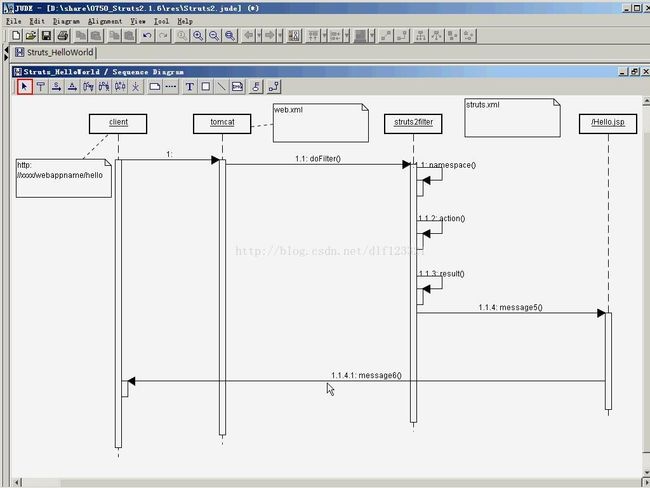尚学堂马士兵struts2 课堂笔记(一)
06_尚学堂马士兵_Struts2_Struts2_HelloWorld_5
<constant name="struts.devMode" value="true" />在默认情况下,刚修改struts.xml后在tomcat中没有立刻刷新要么重新启动tomcat,要么加上上面的常量 dev development
07_尚学堂马士兵_Struts2_Struts2_HelloWorld_6
在eclipse里的struts.xm文件敲<是没有反应的,eclipse没有给出提示,其实eclipse里面也不知道给给出怎么样的提示.
很简单 看struts.xml文件的最上面几行
http://struts.apache.org/dtds/struts-2.0.dtd
这个url就是struts的参考信息,每次去网上拿就比较慢. 打开下载的struts lib文件找到struts2-core-xxx.jar解压缩 在里面就能看到dtd文件
再下来就比较简单了 window preference 在查找里面写catalog 找到xml如下图

09_尚学堂马士兵_Struts2_Struts2_HelloWorld_7_2.
客户端的请求通过相应的端口交给tomcat,tamcat在通过自己的web.xml把请求交给响应的webapp,webapp通过自己的web.xml里面
<filter> <filter-name>struts2</filter-name> <filter-class>org.apache.struts2.dispatcher.ng.filter.StrutsPrepareAndExecuteFilter</filter-class> </filter> <!-- 让Struts2的核心Filter拦截所有请求 --> <filter-mapping> <filter-name>struts2</filter-name> <url-pattern>/*</url-pattern> </filter-mapping>
找到struts.xml在struts里面通过命名空间/actionname/result(其中命名空间后面再谈)找到响应的映射地址 返回给客户端.
其实struts干了什么,这么简单的问题为什么要搞这么复杂?
这就叫做简单问题复杂化,你只有在学习的时候能把简单的问题复杂化,当面对复杂工作的时候,你才能把复杂问题简单化.其实设计模式不就是干了个这事吗?
言归正传,struts到底干了什么?
就是把请求与视图分开!
10_尚学堂马士兵_Struts2_Struts2_Namespace_命名空间
Struts里面有package.这东西是干什么用的?
其实它和java里面的package一样.区分类而已,如果有两个action 都叫loginaction要给是前台的一个是后台的.放到要给package里面肯定不行 所以就有两个package 一个front一个back
ok 就这么简单就 这么方便,甚至不需要动笔 人人都要称呼一声神童啊!
<package name="main" extends="struts-default" namespace="/">
<action name="index">
<result>/Namespace.jsp</result>
</action>
</package>
namespace决定了action的访问路径,默认为"",可以接收所有路径的actionnamespace可以写为/,或者/xxx,或者/xxx/yyy,对应的action访问路径为/index.action,/xxx/index.action,或者/xxx/yyy/index.action.namespace最好也用模块来进行命名
在上面的namespace里是/ 因此我们要访问这个action就localhost:8800/webname/index.action (.action可以省略)
如果改成 namespace="/aa/"那么访问的url就是localhost:8800/webname/aa./index.action (.action可以省略)以此类推
另外也可以给namespace赋为空”” 这个时候其他namespace处理不了的请求都交给它来处理.
这位置不会改变,点项目邮件properties 上面查找web就ok
11_尚学堂马士兵_Struts2_Struts2_Action
<package name="front" extends="struts-default" namespace="/">
<action name="index" class="com.bjsxt.struts2.front.action.IndexAction1">
<result name="success">/ActionIntroduction.jsp</result>
</action>
</package>
index这个action指定的class可以有三种写法
一最普通的类
public class IndexAction1 {
public String execute() {
return "success";
}
}
二实现action接口
import com.opensymphony.xwork2.Action;
public class IndexAction2 implements Action {
@Override
public String execute() {
return "success";
}
}
三继承actionSupport
public class IndexAction3 extends ActionSupport {
@Override
public String execute() {
return "success";
}
}
选择那种方式 ?
第三种!
第一种得自己写,第二种只是实现了action接口,而actionsupport里面已经给我们写好了一些常用的方法.而且actionsupport本身就实现了action接口
再另外
<action name="index">
<result>/Namespace.jsp</result>
</action>
这里面怎么没有 class
没有制定classs就默认使用actionsupport,而actionsupport本身的execute方法返回的就是succes,再看rusult,如果要指定返回success的响应页面,那么success就可以不写.
在上面这种情况下,就是只要你请求index.action我就给你返回Namespace.jsp
12_尚学堂马士兵_Struts2_Struts2_Path_路径问题
Struts里面的如下
<package name="path" extends="struts-default" namespace="/path">
<action name="path" class="com.bjsxt.struts2.path.action.PathAction">
<result name="path">/path.jsp</result>
</action>
</package>
类如下
package com.bjsxt.struts2.path.action;
public class PathAction {
public String execute() {
return "path";
}
}
Index.jsp如下(index.jsp也在webroot下 和path.jsp同级)
<?xml version="1.0" encoding="GB18030" ?>
<%@ page language="java" contentType="text/html; charset=GB18030"
pageEncoding="GB18030"%>
<!DOCTYPE html PUBLIC "-//W3C//DTD XHTML 1.0 Transitional//EN" "http://www.w3.org/TR/xhtml1/DTD/xhtml1-transitional.dtd">
<html xmlns="http://www.w3.org/1999/xhtml">
<head>
<meta http-equiv="Content-Type" content="text/html; charset=GB18030" />
<title>Insert title here</title>
</head>
<body>
<a href="path/path.action">路径问题说明</a>
</body>
</html>
Psth.jsp如下(path.jsp放在webroot目录下)
<?xml version="1.0" encoding="GB18030" ?>
<%@ page language="java" contentType="text/html; charset=GB18030"
pageEncoding="GB18030"%>
<%@taglib uri="/struts-tags" prefix="s" %>
<!DOCTYPE html PUBLIC "-//W3C//DTD XHTML 1.0 Transitional//EN" "http://www.w3.org/TR/xhtml1/DTD/xhtml1-transitional.dtd">
<html xmlns="http://www.w3.org/1999/xhtml">
<head>
<meta http-equiv="Content-Type" content="text/html; charset=GB18030" />
<title>Insert title here</title>
</head>
<body>
struts2中的路径问题是根据action的路径而不是jsp路径来确定,所以尽量不要使用相对路径。<br />
<a href="index.jsp">index.jsp</a>
<br />
虽然可以用redirect方式解决,但redirect方式并非必要。
<br />
解决办法非常简单,统一使用绝对路径。(在jsp中用request.getContextRoot方式来拿到webapp的路径)
<br />
或者使用myeclipse经常用的,指定basePath
</body>
</html>
Index.jsp为webapp的默认页面,最开始访问localhost:8080/webname/是就会看到index.jsp此时点击”路径问题说明”就跳转到了path.jsp
在path.jsp里面你点击index.jsp跳转到了
Localhost:8080/webname/path/index.jsp 看到问题了吧 系统不用关注文件的真实路径.当你在path.jsp.里面点击index时它的路径就是/path了!!
怎么办?使用绝对路径
绝对路径方法一
在jsp加上如下java片
<%
String path = request.getContextPath();
String basePath = request.getScheme()+"://"+request.getServerName()+":"+request.getServerPort()+path+"/";
%>
超链接改成
<a href="<%= bathpath %>index.jsp">index.jsp</a>
绝对路径方法二
在头部加上
<base href="<%=basePath%>" />
下面的路径就默认为bathpath
<a href="index.jsp">index.jsp</a> 这样就可以访问了
13_尚学堂马士兵_Struts2_Struts2_ActionMethod_DMI_动态方法调用
<struts>
<constant name="struts.devMode" value="true" />
<package name="user" extends="struts-default" namespace="/kkk">
<action name="userAdd" class="com.bjsxt.struts2.user.action.UserAction" method="add">
<result>/user_add_success.jsp</result>
</action>
<action name="user" class="com.bjsxt.struts2.user.action.UserAction">
<result>/user_add_success.jsp</result>
</action>
<span style="font-family:Times New Roman;"> </span></package>
</struts>
当在浏览器里敲http://localhost:8080/webapps/kkk/userAdd就可以调用这个action,因为后面跟有有个method=”add”所以调用的不是里面的execute()而是add方法.(不鼓励使用)
第二中就是http://localhost:8080/webapps/kkk!Add(DMI dynamic method invocation) 不过若是你直接就输入上面的url还是不行因为struts2默认不适用dmi所以还得加上
<constant name="struts.enable.DynamicMethodInvocation" value="true"/>
UserAction的类
package com.bjsxt.struts2.user.action;
import com.opensymphony.xwork2.ActionSupport;
public class UserAction extends ActionSupport {
public String add() {
return SUCCESS;
}
}

